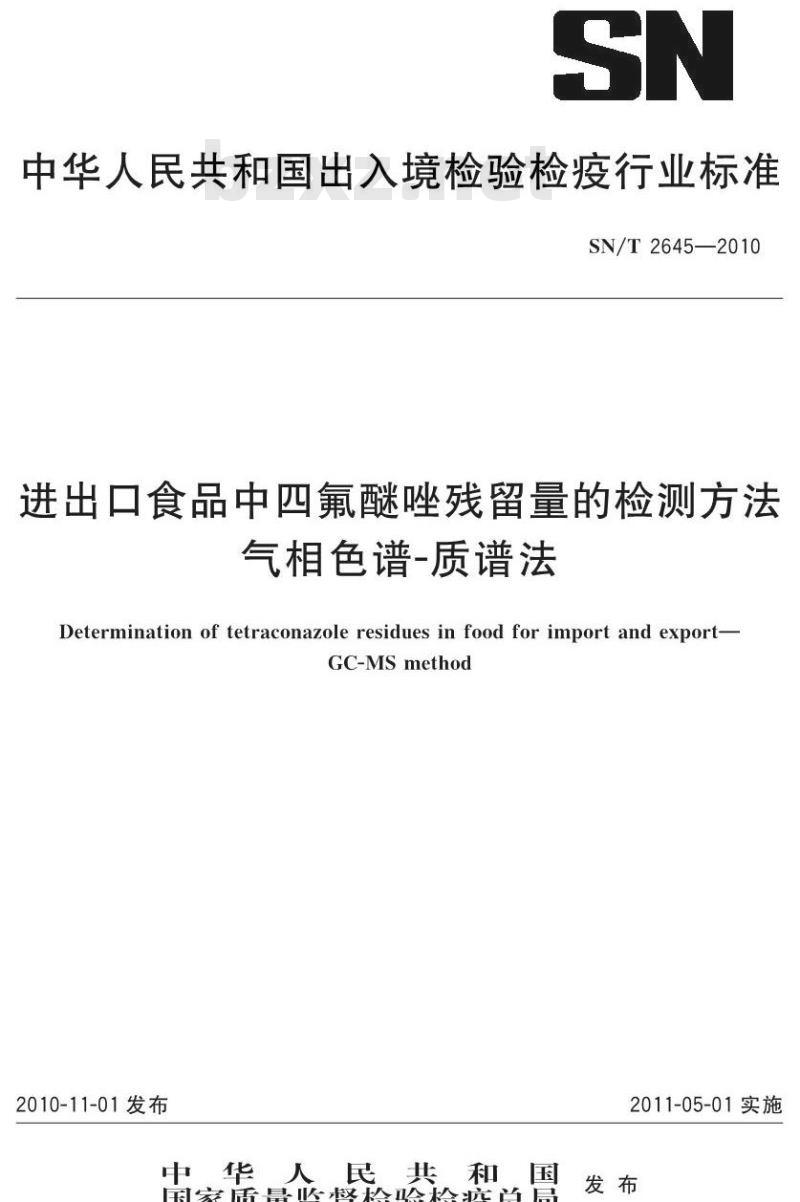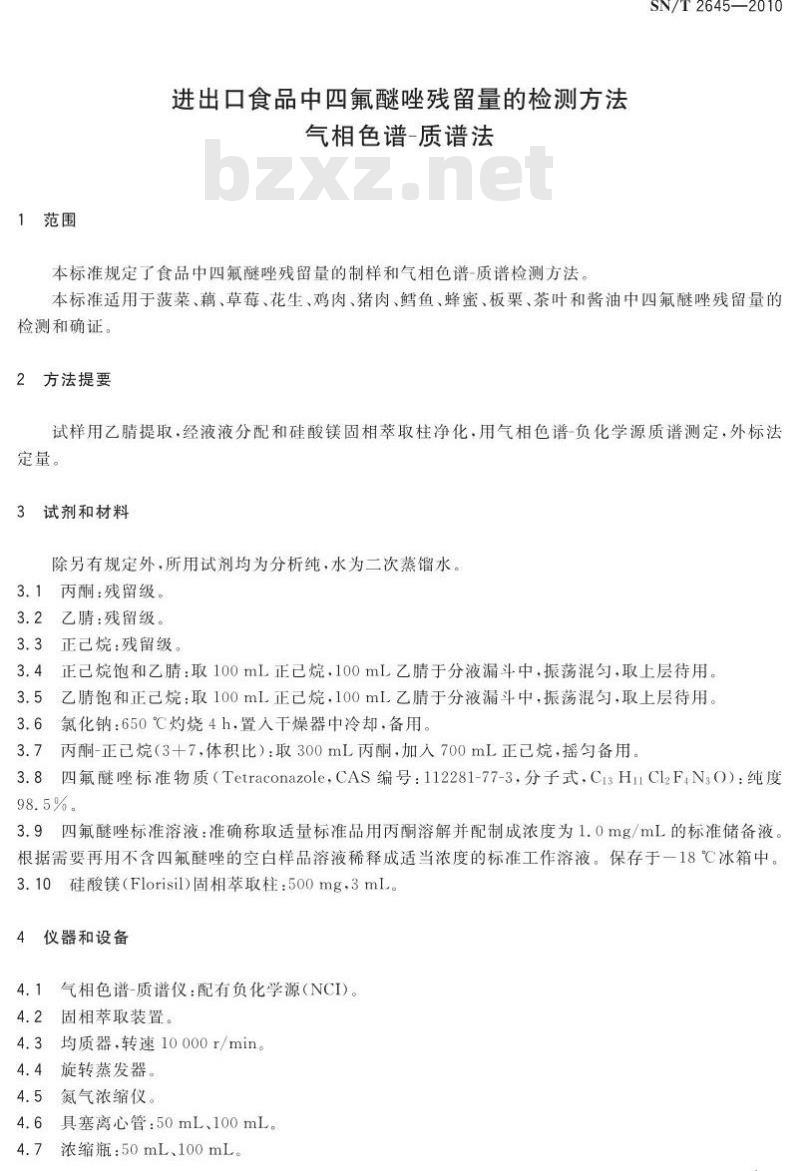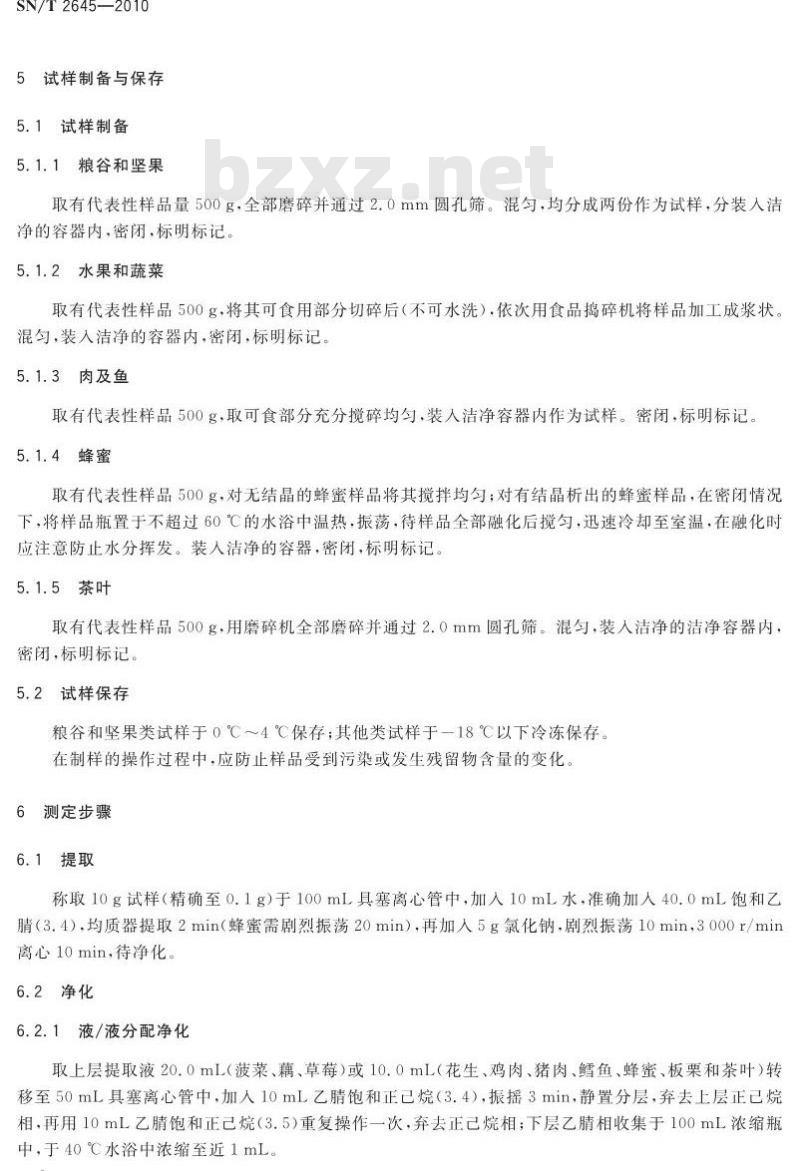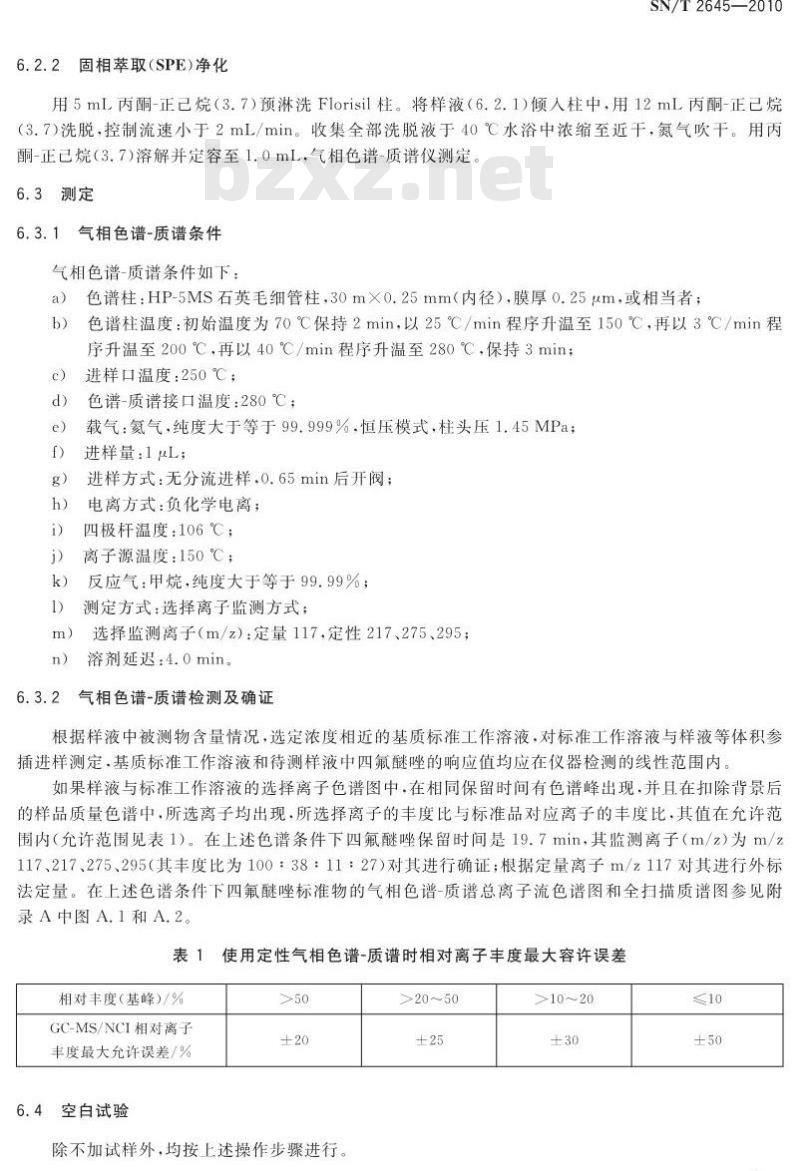- 您的位置:
- 标准下载网 >>
- 标准分类 >>
- 商检行业标准(SN) >>
- SN/T 2645-2010 进出口食品中四氟醚唑残留量的检测方法 气相色谱-质谱法
标准号:
SN/T 2645-2010
标准名称:
进出口食品中四氟醚唑残留量的检测方法 气相色谱-质谱法
标准类别:
商检行业标准(SN)
标准状态:
现行出版语种:
简体中文下载格式:
.rar .pdf下载大小:
部分标准内容:
中华人民共和国出入境检验检疫行业标准SN/T2645—2010
进出口食品中四氟醚唑残留量的检测方法气相色谱-质谱法
Determination of tetraconazole residues in food for import and export-GC-MS method
2010-11-01发布
中华人民共和国
国家质量监督检验检疫总局
2011-05-01实施
本标准按照GB/T1.1—2009给出的规则起草。本标准由国家认证认可监督管理委员会提出并归口。SN/T2645—2010
本标准起草单位:中华人民共和国山东出人境检验检疫局、中华人民共和国湖南出入境检验检疫局、中华人民共和国江苏出人境检验检疫局。本标准主要起草人:主建华、孙忠松、蔡发、王境堂、王艳丽、赵亮、黄志强、沈崇钰1范围
进出口食品中四氟醚唑残留量的检测方法气相色谱-质谱法
本标准规定了食品中四氟醚唑残留量的制样和气相色谱-质谱检测方法。SN/T2645—2010
本标准适用于波菜、藕、草莓、花生、鸡肉、猪肉、鳕鱼、蜂蜜、板栗、茶叶和酱油中四氟醚唑残留量的检测和确证。
2方法提要
试样用乙睛提取,经液液分配和硅酸镁固相萃取柱净化,用气相色谱负化学源质谱测定,外标法定量。
3试剂和材料
除另有规定外,所用试剂均为分析纯,水为二次蒸馏水。3.1丙酮:残留级。
3.2乙睛:残留级。
3.3正已烷:残留级。
3.4正已烷饱和乙睛:取100mL正已烷,100mL乙睛于分液漏斗中,振荡混勾,取上层待用。3.5乙睛饱和正已烷:取100mL正已烷,100mL乙睛于分液漏斗中,振荡混匀,取上层待用。3.6氯化钠:650℃灼烧4h,置入干燥器中冷却,备用。3.7丙酮-正已烷(3+7,体积比):取300mL丙酮,加入700mL正已烷,摇匀备用。3.8四氟醚唑标准物质(Tetraconazole,CAS编号:112281-77-3,分子式,Ci3HiCl2F4N3O):纯度98.5%。
3.9四氟醚唑标准溶液:准确称取适量标准品用丙酮溶解并配制成浓度为1.0mg/mL的标准储备液根据需要再用不含四氟醚唑的空白样品溶液稀释成适当浓度的标准工作溶液。保存于一18C冰箱中。3.10硅酸镁(Florisil)固相萃取柱:500mg.3mL。4
仪器和设备
4.1气相色谱-质谱仪:配有负化学源(NCI)。4.2固相萃取装置。
4.3均质器,转速10000r/min。
4.4旋转蒸发器。
4.5氮气浓缩仪。
4.6具塞离心管:50mL、100mL。4.7浓缩瓶:50mL、100mL。
SN/T2645—2010
5试样制备与保存
5.1试样制备
5.1.1粮谷和坚果
取有代表性样品量500g,全部磨碎并通过2.0mm圆孔筛。混匀,均分成两份作为试样,分装人洁净的容器内,密闭,标明标记
5.1.2水果和蔬菜
取有代表性样品500g,将其可食用部分切碎后(不可水洗),依次用食品捣碎机将样品加工成浆状混匀,装入洁净的容器内,密闭,标明标记。5.1.3肉及鱼
取有代表性样品500g,取可食部分充分搅碎均匀,装人洁净容器内作为试样。密闭,标明标记,5.1.4蜂蜜
取有代表性样品500g,对无结晶的蜂蜜样品将其搅拌均勾;对有结晶析出的蜂蜜样品,在密闭情况下,将样品瓶置于不超过60℃的水浴中温热,振荡,待样品全部融化后搅勾,迅速冷却至室温,在融化时应注意防止水分挥发。装人洁净的容器,密闭,标明标记。5.1.5茶叶
取有代表性样品500g,用磨碎机全部磨碎并通过2.0mm圆孔筛。混匀,装人洁净的洁净容器内密闭,标明标记。
5.2试样保存
粮谷和坚果类试样于0℃~4℃保存;其他类试样于一18℃以下冷冻保存。在制样的操作过程中,应防止样品受到污染或发生残留物含量的变化6
测定步骤
6.1提取
称取10g试样(精确至0.1g)于100mL具塞离心管中,加人10mL水.准确加人40.0mL饱和睛(3.4),均质器提取2min(蜂蜜需剧烈振荡20min),再加人5g氯化钠,剧烈振荡10min,3000r/min离心10min,待净化。
6.2净化
6.2.1液/液分配净化
取上层提取液20.0mL(菠菜、藕、草莓)或10.0mL(花生、鸡肉、猪肉、鳕鱼、蜂蜜、板栗和茶叶)转移至50mL具塞离心管中,加人10mL乙睛饱和正已烷(3.4),振摇3min,静置分层,弃去上层正已烷相,再用10mL乙睛饱和正已烷(3.5)重复操作一次,弃去正已烷相;下层乙睛相收集于100mL浓缩瓶中,于40℃水浴中浓缩至近1mL。2
6.2.2固相萃取(SPE)净化
SN/T2645—2010
用5mL内酮-正已烷(3.7)预淋洗Florisil柱。将样液(6.2.1)倾入柱中,用12mL丙酮-正已烷(3.7)洗脱,控制流速小于2mL/min。收集全部洗脱液于40℃水浴中浓缩至近干,氮气吹干。用丙酮-正已烷(3.7)溶解并定容至1.0mL,气相色谱-质谱仪测定。6.3测定
6.3.1气相色谱-质谱条件
气相色谱-质谱条件如下:
a)色谱柱:HP-5MS石英毛细管柱,30mX0.25mm(内径),膜厚0.25um,或相当者;b)食
色谱柱温度:初始温度为70℃保持2min,以25℃/min程序升温至150℃,再以3℃/min程序升温至200℃,再以40℃/min程序升温至280℃,保持3min;e
进样口温度:250℃;
色谱-质谱接口温度:280℃:
载气:氨气,纯度大于等于99.999%.恒压模式,柱头压1.45MPa;e)
进样量:lμL;
进样方式:无分流进样,0.65min后开阀;h)
电离方式:负化学电离;
四极杆温度:106℃;
离子源温度:150℃;
反应气:甲烷,纯度大于等于99.99%;1)
测定方式:选择离子监测方式:m)
选择监测离子(m/z):定量117,定性217、275、295n)
溶剂延迟:4.0min。
6.3.2气相色谱-质谱检测及确证根据样液中被测物含量情况,选定浓度相近的基质标准工作溶液对标准工作溶液与样液等体积参插进样测定,基质标准工作溶液和待测样液中四氟醚唑的响应值均应在仪器检测的线性范围内。如果样液与标准工作溶液的选择离子色谱图中,在相同保留时间有色谱峰出现,并且在扣除背景后的样品质量色谱中,所选离子均出现,所选择离子的丰度比与标准品对应离子的丰度比,其值在允许范围内(允许范围见表1)。在上述色谱条件下四氟醚唑保留时间是19.7min,其监测离子(m/z)为m/z117、217、275、295(其丰度比为100:38:11:27)对其进行确证;根据定量离子m/z117对其进行外标法定量。在上述色谱条件下四氟醚唑标准物的气相色谱-质谱总离子流色谱图和全扫描质谱图参见附录A中图A.1和A.2。
表1使用定性气相色谱-质谱时相对离子丰度最大容许误差相对丰度(基峰)/%
GC-MS/NCI相对离子
丰度最大允许误差/%
6.4空白试验
除不加试样外,均按上述操作步骤进行。>20~50
>10~20
SN/T2645—2010
结果计算和表述
用色谱数据处理机或按式(1)计算试样中四氟醚唑残留量:hxexv
式中:
试样中四氟醚唑残留量,单位为毫克每千克(mg/kg):样液中四氟醚唑的色谱峰高:
标准工作液中四氟醚唑的色谱峰高;标准工作液中四氟醚唑的浓度,单位为微克每毫升(ug/mL);样液最终定容体积,单位为毫升(mL);最终样液所代表的试样质量,单位为克(g)。测定低限和回收率
测定低限
本方法的测定低限为0.010mg/kg。回收率
样品添加浓度及回收率范围的实验数据见表2。表2
添加浓度
样品添加浓度及回收率范围的实验数据回收率范围
90.0~110.0
95.0~107.5
97.0~105.0
90.0~110.0
97.5~112.5
96.0~105.0
95.0~111.0
97.5~~105.5
95.0~105.0
90.0~-110.0
96.0~107.5
98.0~107.0
95.0~110.0
97.5~107.5
94.0~106.0
95.0110.0
92.5~102.5
95.0112.0
添加浓度
回收率范围
90.0~110.0
97.5~104.5免费标准下载网bzxz
94.0~112.0
90.0~110.0
97.5~105.0
98.05103.0
95.0110.0
92.5~107.5
95.0~106.0
90.0~110.0
97.5~112.5
95.0~105.0
90.0~110.0
95.0~107.5
94.0~106.0
Atumlane
Abumdiance
20 000
附录A
(资料性附录)
四氟醚唑标准物质色谱图
四氟醚唑标准物的气相色谱-质谱总离子流色谱图217
351371
四氟醚唑标准物质气相色谱-质谱图450
SN/T2645—2010
SN/T2645—2010
Foreword
This standard was proposed by and is under the charge of the Certification and Accreditation AdminstrationofthePeoplesRepublicofChinaThis standard was drafted by the Shandong Entry-Exit Inspection and Quarantine Bureau,Hunan En-try-ExitInspectionandQuarantineBureau and Jiangsuof thePeople'sRepublicofChinaThis main drafters of this standard:Wangjianhua、Sunzhongsong、Wang jingtang、Caifa、Wang yanliZhaoliang、HuangZhiqiang、ShenchongyuSN/T2645—2010
DeterminationoftetraconazoleresiduesinfoodforimportandexportGc-MSmethod
This standard specifies the method of sample preparation and determination of tetraconazole residueinfoodstuffsbygaschromatography-massspectrometryThis standard isapplicable to the determination and confirmationof tetraconazole residue in spinach,lotus,strawberry.peanut,chicken.pork.ling,honey.chestnut.teaand soy2Principle
The test sample is extracted with acetonitrile,then the extract is partitioned with n-hexane beforecleaning up procedure bypassing through a Florisil solid phase extraction(SPE)column.Residue isdetermined by GC-NCI-MSand quantitated by external standard method.3 Reagents and materials
All the reagents used should be analytically pure unless otherwise specified.\Water”is redistilledwater.
Acetonitrile.
n-Hexane
Saturatedacetonitrile:SaturatedwithhexaneSaturated hexane:Saturatedwithacetonitrile3.5
Sodiumchloride:Driedat650℃for4h,andstoredinasealedcontainer3.7
Acetone-n-Hexane (3+7.V/V):Dilute 30o mL acetone with n-Hexane to the volumeof1000mL.3.6.
SN/T2645—2010
Tetraconazole standard(Tetraconazole,C13H1Cl2F4N3O,CASNo.:112281-77-3):Purity96.5%.
Standard stock solution:Accurately weigh appropriate amount of tetraconazole standard anddissolve with a little volume of acetone followed by a further dilution to the final concentration of1oo0μg/mL.Thendilutethestandardstocksolutionwithacetonetomakestandardworkingsolutionofrequiredconcentrationandstoredat-18withashelflifeof sixmonths.3.10FlorisilSPEcolumns:0.5g.3mLApparatus and equipment
Gaschromatographyequippedwithnegativechemicalionizationmassspectrometry4.2 Column processor.
4.3Homogenizer:10000r/min.
4.4 Rotary vacuum evaporator.4.5Nitrogenevaporator.
Centrifugetube,50mL,100mLwithstopper4.7
Concentratingbottle:50mL,100mLPreparationand storageof testsample5
5.1 Preparation of test sample5.1.1Cereals and nut
Take approximately 500 g of representative sample.Grind with a grinder to pass through a 2.0 mmround-hole sieve.Mix thoroughly and divide into two equal portions.Each portion is placed into aclean container,as test sample,sealed and labelled.5.1.2Fruitsandvegetables
Takeapproximately5oogof.representativesample(witoutwashbywater).The edible partsareblended and homogenized in a high speed blender.Divide into two equal portions.Each portionisplacedintoacleancontainerastestsample,sealedandlabeled.8
5.1.3Meatandfish
SN/T2645—2010
Take approximately500g of representative sample.The edible parts areblended and homogenized ina high speed blender.Divide into two equal portions.Each portion is placed into a clean container asthe test sample,sealed and labeled.5.1.4Honeyandhoneyproduct
Takeapproximately5oogof representativesample.Homogenize thenon-crystallizationhoneyandthecrystallized honey in the sample bottle should be warmed under waterbath at the temperatureof nomore than 60.Shake the bottle until the sample is completely dissolved.Sample should be homog-enized and cooled down to room temperature rapidly.Do prevent the evaporating of waterduring theheatingprocedure.Thenplace into a cleancontaineras thetest sample,sealed and labeled.5.1.5Tea
Takeapproximately500gof representative sample.Grind and pass through a 2.0 mm round-holesieve.Mix thoroughly and place into a clean container as the test sample,sealed and labeled5.2Storageoftestsample
Thetest samples of cereals and nut shall be stored at the range of 0 C ~4 .The test samples offruitsandvegetablesshouldbestoredbelow-18℃.During samplingand samplepreparation.precaution shall be taken toavoid contamination oranyfac-torswhichmaycausethechangeofresiduecontent.6Procedure
6.1Extraction
Weigh10 g of thetest sample intoa 100 mL centrifuge tube equipped witha stopper.Andaccuratelyadd 10mL of water.40.0 mL saturated acetonitrile(3.5)into theflask.Extract for 2mininahighspeed homogenizer(4.3).Add5gSodium chloride(3.4),shakefor10min,centrifugefor10 minat3000r/min.
6.2Cleaning up
6.2.1Liquid/liquidpartition
Transferthe20.0mL(spinach.lotus.strawberry)or10.0mL(peanut,chicken.pork,ling.honey9
SN/T2645—2010
chestnut.and tea)of supernatant into a 50 mL centrifuge tube(4.5),add 10 mL of saturated hexane(3.6),shakefor3minandplaceasideforseparation.Discardthehexanephase.Repeataboveprocedure and condenseacetonitrileto nearlydryness bya rotary evaporatorat 4oC.Dissolvethe residuewith 1mL of acetone-hexane(3.7)for SPE purification6. 2. 2 SPE cleaning up
Rinseaflorisil column with5mL of acetone-hexane(3.7).Loadthe above solution to column,andelutethecolumnwith12mLofacetone-hexane(3.5).all eluatesaretransferedintoa50mLconcen-tratebottleandevaporatedtodrynessbyarotaryevaporatorat4oC.Dissolvetheresiduewithace-tone-hexane(3.7)toexactvolumeof1.0mLfordeterminationbyGC-MS6.3Determination
6.3.1GC-MSoperatingconditionChromatographiccolumn:HP-5MSsilicacapillarycolumn30m×0.25mm(i.d.).0.25μmfilma)
thickness,and or equivalent;b)
Columntemperature:70℃for2min.rampat25℃/minto150℃,rampat3℃/minto200℃.and then increase at40℃/min to280℃.hold for3min;c)
Injectortemperature:250℃
Interface temperature:280℃ ;d)
Carriergas:Helium.purity≥99.999%,constantpressuremode:14.5MPaInjectionvolume:1μL
InjectionmodeSplitless,openthevalveafter0.65min;h)
Electricalionizationmode:NCl;Quadropoletemperature:106℃j
lon sourcetemperature:150℃;k)
Methane≥99.99%;
Selected ion monitoring mode:Monitoringions(m/z):quantitiedby117.qualifiedby217.275.295;10
小提示:此标准内容仅展示完整标准里的部分截取内容,若需要完整标准请到上方自行免费下载完整标准文档。
进出口食品中四氟醚唑残留量的检测方法气相色谱-质谱法
Determination of tetraconazole residues in food for import and export-GC-MS method
2010-11-01发布
中华人民共和国
国家质量监督检验检疫总局
2011-05-01实施
本标准按照GB/T1.1—2009给出的规则起草。本标准由国家认证认可监督管理委员会提出并归口。SN/T2645—2010
本标准起草单位:中华人民共和国山东出人境检验检疫局、中华人民共和国湖南出入境检验检疫局、中华人民共和国江苏出人境检验检疫局。本标准主要起草人:主建华、孙忠松、蔡发、王境堂、王艳丽、赵亮、黄志强、沈崇钰1范围
进出口食品中四氟醚唑残留量的检测方法气相色谱-质谱法
本标准规定了食品中四氟醚唑残留量的制样和气相色谱-质谱检测方法。SN/T2645—2010
本标准适用于波菜、藕、草莓、花生、鸡肉、猪肉、鳕鱼、蜂蜜、板栗、茶叶和酱油中四氟醚唑残留量的检测和确证。
2方法提要
试样用乙睛提取,经液液分配和硅酸镁固相萃取柱净化,用气相色谱负化学源质谱测定,外标法定量。
3试剂和材料
除另有规定外,所用试剂均为分析纯,水为二次蒸馏水。3.1丙酮:残留级。
3.2乙睛:残留级。
3.3正已烷:残留级。
3.4正已烷饱和乙睛:取100mL正已烷,100mL乙睛于分液漏斗中,振荡混勾,取上层待用。3.5乙睛饱和正已烷:取100mL正已烷,100mL乙睛于分液漏斗中,振荡混匀,取上层待用。3.6氯化钠:650℃灼烧4h,置入干燥器中冷却,备用。3.7丙酮-正已烷(3+7,体积比):取300mL丙酮,加入700mL正已烷,摇匀备用。3.8四氟醚唑标准物质(Tetraconazole,CAS编号:112281-77-3,分子式,Ci3HiCl2F4N3O):纯度98.5%。
3.9四氟醚唑标准溶液:准确称取适量标准品用丙酮溶解并配制成浓度为1.0mg/mL的标准储备液根据需要再用不含四氟醚唑的空白样品溶液稀释成适当浓度的标准工作溶液。保存于一18C冰箱中。3.10硅酸镁(Florisil)固相萃取柱:500mg.3mL。4
仪器和设备
4.1气相色谱-质谱仪:配有负化学源(NCI)。4.2固相萃取装置。
4.3均质器,转速10000r/min。
4.4旋转蒸发器。
4.5氮气浓缩仪。
4.6具塞离心管:50mL、100mL。4.7浓缩瓶:50mL、100mL。
SN/T2645—2010
5试样制备与保存
5.1试样制备
5.1.1粮谷和坚果
取有代表性样品量500g,全部磨碎并通过2.0mm圆孔筛。混匀,均分成两份作为试样,分装人洁净的容器内,密闭,标明标记
5.1.2水果和蔬菜
取有代表性样品500g,将其可食用部分切碎后(不可水洗),依次用食品捣碎机将样品加工成浆状混匀,装入洁净的容器内,密闭,标明标记。5.1.3肉及鱼
取有代表性样品500g,取可食部分充分搅碎均匀,装人洁净容器内作为试样。密闭,标明标记,5.1.4蜂蜜
取有代表性样品500g,对无结晶的蜂蜜样品将其搅拌均勾;对有结晶析出的蜂蜜样品,在密闭情况下,将样品瓶置于不超过60℃的水浴中温热,振荡,待样品全部融化后搅勾,迅速冷却至室温,在融化时应注意防止水分挥发。装人洁净的容器,密闭,标明标记。5.1.5茶叶
取有代表性样品500g,用磨碎机全部磨碎并通过2.0mm圆孔筛。混匀,装人洁净的洁净容器内密闭,标明标记。
5.2试样保存
粮谷和坚果类试样于0℃~4℃保存;其他类试样于一18℃以下冷冻保存。在制样的操作过程中,应防止样品受到污染或发生残留物含量的变化6
测定步骤
6.1提取
称取10g试样(精确至0.1g)于100mL具塞离心管中,加人10mL水.准确加人40.0mL饱和睛(3.4),均质器提取2min(蜂蜜需剧烈振荡20min),再加人5g氯化钠,剧烈振荡10min,3000r/min离心10min,待净化。
6.2净化
6.2.1液/液分配净化
取上层提取液20.0mL(菠菜、藕、草莓)或10.0mL(花生、鸡肉、猪肉、鳕鱼、蜂蜜、板栗和茶叶)转移至50mL具塞离心管中,加人10mL乙睛饱和正已烷(3.4),振摇3min,静置分层,弃去上层正已烷相,再用10mL乙睛饱和正已烷(3.5)重复操作一次,弃去正已烷相;下层乙睛相收集于100mL浓缩瓶中,于40℃水浴中浓缩至近1mL。2
6.2.2固相萃取(SPE)净化
SN/T2645—2010
用5mL内酮-正已烷(3.7)预淋洗Florisil柱。将样液(6.2.1)倾入柱中,用12mL丙酮-正已烷(3.7)洗脱,控制流速小于2mL/min。收集全部洗脱液于40℃水浴中浓缩至近干,氮气吹干。用丙酮-正已烷(3.7)溶解并定容至1.0mL,气相色谱-质谱仪测定。6.3测定
6.3.1气相色谱-质谱条件
气相色谱-质谱条件如下:
a)色谱柱:HP-5MS石英毛细管柱,30mX0.25mm(内径),膜厚0.25um,或相当者;b)食
色谱柱温度:初始温度为70℃保持2min,以25℃/min程序升温至150℃,再以3℃/min程序升温至200℃,再以40℃/min程序升温至280℃,保持3min;e
进样口温度:250℃;
色谱-质谱接口温度:280℃:
载气:氨气,纯度大于等于99.999%.恒压模式,柱头压1.45MPa;e)
进样量:lμL;
进样方式:无分流进样,0.65min后开阀;h)
电离方式:负化学电离;
四极杆温度:106℃;
离子源温度:150℃;
反应气:甲烷,纯度大于等于99.99%;1)
测定方式:选择离子监测方式:m)
选择监测离子(m/z):定量117,定性217、275、295n)
溶剂延迟:4.0min。
6.3.2气相色谱-质谱检测及确证根据样液中被测物含量情况,选定浓度相近的基质标准工作溶液对标准工作溶液与样液等体积参插进样测定,基质标准工作溶液和待测样液中四氟醚唑的响应值均应在仪器检测的线性范围内。如果样液与标准工作溶液的选择离子色谱图中,在相同保留时间有色谱峰出现,并且在扣除背景后的样品质量色谱中,所选离子均出现,所选择离子的丰度比与标准品对应离子的丰度比,其值在允许范围内(允许范围见表1)。在上述色谱条件下四氟醚唑保留时间是19.7min,其监测离子(m/z)为m/z117、217、275、295(其丰度比为100:38:11:27)对其进行确证;根据定量离子m/z117对其进行外标法定量。在上述色谱条件下四氟醚唑标准物的气相色谱-质谱总离子流色谱图和全扫描质谱图参见附录A中图A.1和A.2。
表1使用定性气相色谱-质谱时相对离子丰度最大容许误差相对丰度(基峰)/%
GC-MS/NCI相对离子
丰度最大允许误差/%
6.4空白试验
除不加试样外,均按上述操作步骤进行。>20~50
>10~20
SN/T2645—2010
结果计算和表述
用色谱数据处理机或按式(1)计算试样中四氟醚唑残留量:hxexv
式中:
试样中四氟醚唑残留量,单位为毫克每千克(mg/kg):样液中四氟醚唑的色谱峰高:
标准工作液中四氟醚唑的色谱峰高;标准工作液中四氟醚唑的浓度,单位为微克每毫升(ug/mL);样液最终定容体积,单位为毫升(mL);最终样液所代表的试样质量,单位为克(g)。测定低限和回收率
测定低限
本方法的测定低限为0.010mg/kg。回收率
样品添加浓度及回收率范围的实验数据见表2。表2
添加浓度
样品添加浓度及回收率范围的实验数据回收率范围
90.0~110.0
95.0~107.5
97.0~105.0
90.0~110.0
97.5~112.5
96.0~105.0
95.0~111.0
97.5~~105.5
95.0~105.0
90.0~-110.0
96.0~107.5
98.0~107.0
95.0~110.0
97.5~107.5
94.0~106.0
95.0110.0
92.5~102.5
95.0112.0
添加浓度
回收率范围
90.0~110.0
97.5~104.5免费标准下载网bzxz
94.0~112.0
90.0~110.0
97.5~105.0
98.05103.0
95.0110.0
92.5~107.5
95.0~106.0
90.0~110.0
97.5~112.5
95.0~105.0
90.0~110.0
95.0~107.5
94.0~106.0
Atumlane
Abumdiance
20 000
附录A
(资料性附录)
四氟醚唑标准物质色谱图
四氟醚唑标准物的气相色谱-质谱总离子流色谱图217
351371
四氟醚唑标准物质气相色谱-质谱图450
SN/T2645—2010
SN/T2645—2010
Foreword
This standard was proposed by and is under the charge of the Certification and Accreditation AdminstrationofthePeoplesRepublicofChinaThis standard was drafted by the Shandong Entry-Exit Inspection and Quarantine Bureau,Hunan En-try-ExitInspectionandQuarantineBureau and Jiangsuof thePeople'sRepublicofChinaThis main drafters of this standard:Wangjianhua、Sunzhongsong、Wang jingtang、Caifa、Wang yanliZhaoliang、HuangZhiqiang、ShenchongyuSN/T2645—2010
DeterminationoftetraconazoleresiduesinfoodforimportandexportGc-MSmethod
This standard specifies the method of sample preparation and determination of tetraconazole residueinfoodstuffsbygaschromatography-massspectrometryThis standard isapplicable to the determination and confirmationof tetraconazole residue in spinach,lotus,strawberry.peanut,chicken.pork.ling,honey.chestnut.teaand soy2Principle
The test sample is extracted with acetonitrile,then the extract is partitioned with n-hexane beforecleaning up procedure bypassing through a Florisil solid phase extraction(SPE)column.Residue isdetermined by GC-NCI-MSand quantitated by external standard method.3 Reagents and materials
All the reagents used should be analytically pure unless otherwise specified.\Water”is redistilledwater.
Acetonitrile.
n-Hexane
Saturatedacetonitrile:SaturatedwithhexaneSaturated hexane:Saturatedwithacetonitrile3.5
Sodiumchloride:Driedat650℃for4h,andstoredinasealedcontainer3.7
Acetone-n-Hexane (3+7.V/V):Dilute 30o mL acetone with n-Hexane to the volumeof1000mL.3.6.
SN/T2645—2010
Tetraconazole standard(Tetraconazole,C13H1Cl2F4N3O,CASNo.:112281-77-3):Purity96.5%.
Standard stock solution:Accurately weigh appropriate amount of tetraconazole standard anddissolve with a little volume of acetone followed by a further dilution to the final concentration of1oo0μg/mL.Thendilutethestandardstocksolutionwithacetonetomakestandardworkingsolutionofrequiredconcentrationandstoredat-18withashelflifeof sixmonths.3.10FlorisilSPEcolumns:0.5g.3mLApparatus and equipment
Gaschromatographyequippedwithnegativechemicalionizationmassspectrometry4.2 Column processor.
4.3Homogenizer:10000r/min.
4.4 Rotary vacuum evaporator.4.5Nitrogenevaporator.
Centrifugetube,50mL,100mLwithstopper4.7
Concentratingbottle:50mL,100mLPreparationand storageof testsample5
5.1 Preparation of test sample5.1.1Cereals and nut
Take approximately 500 g of representative sample.Grind with a grinder to pass through a 2.0 mmround-hole sieve.Mix thoroughly and divide into two equal portions.Each portion is placed into aclean container,as test sample,sealed and labelled.5.1.2Fruitsandvegetables
Takeapproximately5oogof.representativesample(witoutwashbywater).The edible partsareblended and homogenized in a high speed blender.Divide into two equal portions.Each portionisplacedintoacleancontainerastestsample,sealedandlabeled.8
5.1.3Meatandfish
SN/T2645—2010
Take approximately500g of representative sample.The edible parts areblended and homogenized ina high speed blender.Divide into two equal portions.Each portion is placed into a clean container asthe test sample,sealed and labeled.5.1.4Honeyandhoneyproduct
Takeapproximately5oogof representativesample.Homogenize thenon-crystallizationhoneyandthecrystallized honey in the sample bottle should be warmed under waterbath at the temperatureof nomore than 60.Shake the bottle until the sample is completely dissolved.Sample should be homog-enized and cooled down to room temperature rapidly.Do prevent the evaporating of waterduring theheatingprocedure.Thenplace into a cleancontaineras thetest sample,sealed and labeled.5.1.5Tea
Takeapproximately500gof representative sample.Grind and pass through a 2.0 mm round-holesieve.Mix thoroughly and place into a clean container as the test sample,sealed and labeled5.2Storageoftestsample
Thetest samples of cereals and nut shall be stored at the range of 0 C ~4 .The test samples offruitsandvegetablesshouldbestoredbelow-18℃.During samplingand samplepreparation.precaution shall be taken toavoid contamination oranyfac-torswhichmaycausethechangeofresiduecontent.6Procedure
6.1Extraction
Weigh10 g of thetest sample intoa 100 mL centrifuge tube equipped witha stopper.Andaccuratelyadd 10mL of water.40.0 mL saturated acetonitrile(3.5)into theflask.Extract for 2mininahighspeed homogenizer(4.3).Add5gSodium chloride(3.4),shakefor10min,centrifugefor10 minat3000r/min.
6.2Cleaning up
6.2.1Liquid/liquidpartition
Transferthe20.0mL(spinach.lotus.strawberry)or10.0mL(peanut,chicken.pork,ling.honey9
SN/T2645—2010
chestnut.and tea)of supernatant into a 50 mL centrifuge tube(4.5),add 10 mL of saturated hexane(3.6),shakefor3minandplaceasideforseparation.Discardthehexanephase.Repeataboveprocedure and condenseacetonitrileto nearlydryness bya rotary evaporatorat 4oC.Dissolvethe residuewith 1mL of acetone-hexane(3.7)for SPE purification6. 2. 2 SPE cleaning up
Rinseaflorisil column with5mL of acetone-hexane(3.7).Loadthe above solution to column,andelutethecolumnwith12mLofacetone-hexane(3.5).all eluatesaretransferedintoa50mLconcen-tratebottleandevaporatedtodrynessbyarotaryevaporatorat4oC.Dissolvetheresiduewithace-tone-hexane(3.7)toexactvolumeof1.0mLfordeterminationbyGC-MS6.3Determination
6.3.1GC-MSoperatingconditionChromatographiccolumn:HP-5MSsilicacapillarycolumn30m×0.25mm(i.d.).0.25μmfilma)
thickness,and or equivalent;b)
Columntemperature:70℃for2min.rampat25℃/minto150℃,rampat3℃/minto200℃.and then increase at40℃/min to280℃.hold for3min;c)
Injectortemperature:250℃
Interface temperature:280℃ ;d)
Carriergas:Helium.purity≥99.999%,constantpressuremode:14.5MPaInjectionvolume:1μL
InjectionmodeSplitless,openthevalveafter0.65min;h)
Electricalionizationmode:NCl;Quadropoletemperature:106℃j
lon sourcetemperature:150℃;k)
Methane≥99.99%;
Selected ion monitoring mode:Monitoringions(m/z):quantitiedby117.qualifiedby217.275.295;10
小提示:此标准内容仅展示完整标准里的部分截取内容,若需要完整标准请到上方自行免费下载完整标准文档。
标准图片预览:





- 热门标准
- 地方标准
- SN/T1509-2005 异尖线虫病诊断规程
- SN/T1395.2-2005 禽衣原体病琼脂免疫扩散试验操作规程
- SN/T3241.7-2013 进出口家用及类似用途电器检验技术要求 第7部分:储水式电热水器的能效
- SN/T3742-2013 国境口岸西尼罗病毒检测方法 实时荧光RT-PCR法
- SN029-93 出口水果中双甲脒残留量检验方法
- SN/T3079.1-2012 进出口安全技术防范产品检验规程第1部分:安全防范报警设备
- SN/T0877-2000 进出口发菜检验规程
- SN/T1853-2006 进出口两轮全场地车检验规程
- SN/T1874-2007 猪细小病毒病聚合酶链反应操作规程
- SN/T2526-2010 鲜切花溴甲烷库房熏蒸除害处理规程
- SN0148-92 出口水果中甲基毒死蜱残留量检验方法
- SN0167-92 出口啤酒花中六六六、滴滴涕残留量检验方法
- SN/T4381-2015 食品接触材料纸、再生纤维材料使用改性聚苯醚测定纸和纸板迁移物的试验方法
- SN/T1443.2-2004 食品安全管理体系 审核指南
- SN0530-1996 出口肉中呋喃唑酮残留量的检验方法液相色谱法
- 行业新闻
请牢记:“bzxz.net”即是“标准下载”四个汉字汉语拼音首字母与国际顶级域名“.net”的组合。 ©2025 标准下载网 www.bzxz.net 本站邮件:bzxznet@163.com
网站备案号:湘ICP备2025141790号-2
网站备案号:湘ICP备2025141790号-2